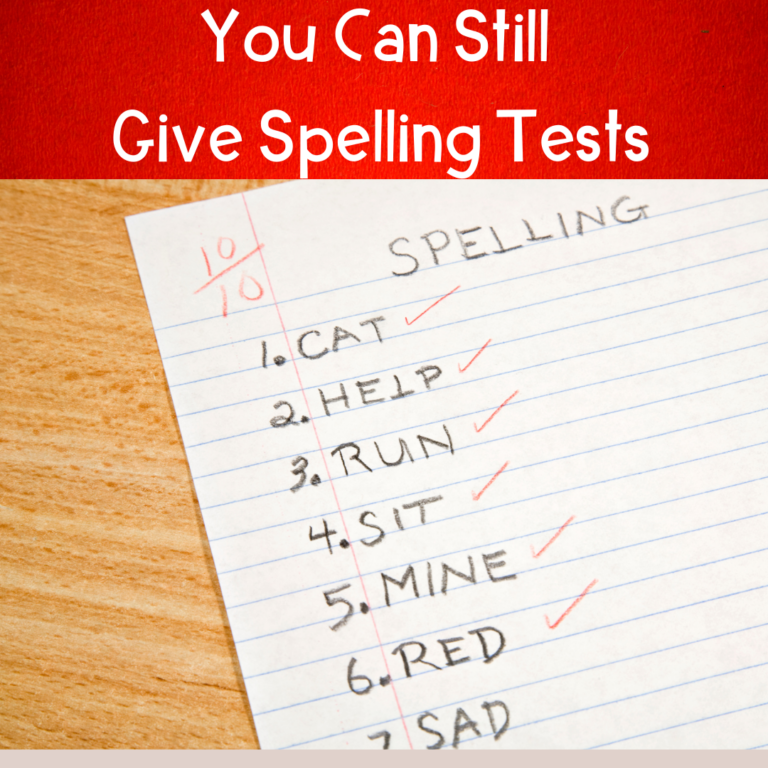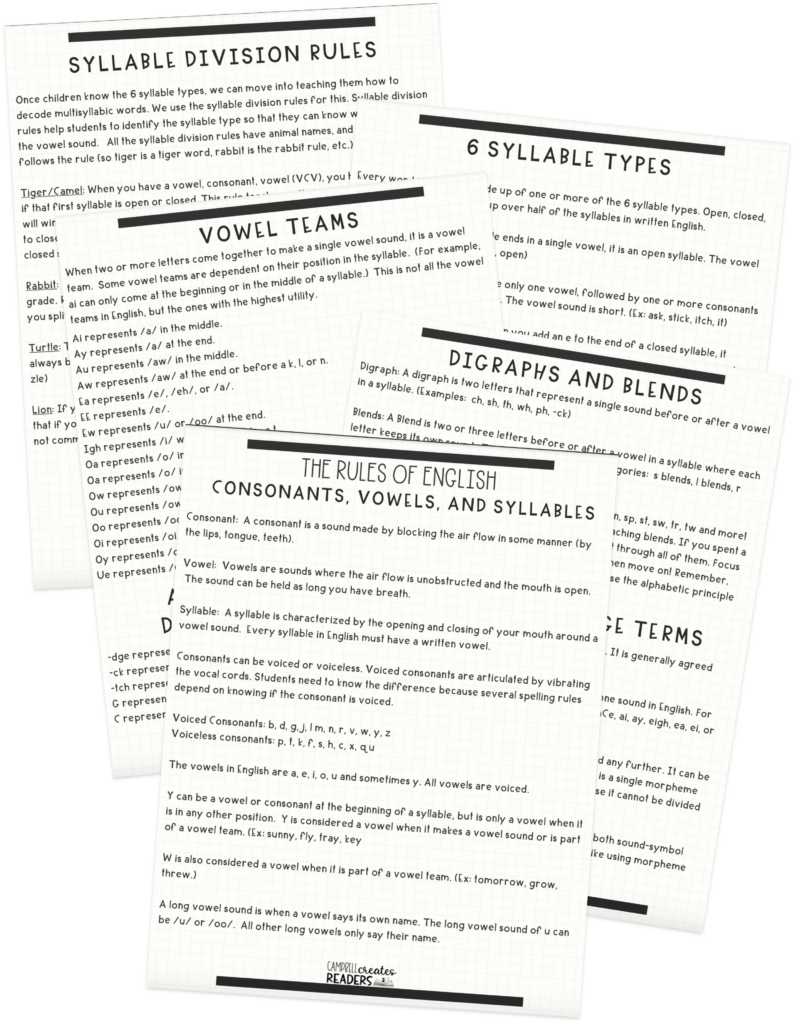
Share This:
In 1997, the National Reading Panel was convened at the behest of Congress and the Secretary of Education. It was formed to “assess the status of research-based knowledge, including the effectiveness of various approaches to teaching children to read”(National Reading Panel, 2000, p.1-1). In 2000, the National Reading Panel (NRP) released their report, a document free to the public. The document is over 400 pages, but gives valuable insights into what research suggests concerning key topics in education.
Though the National Reading Panel’s report was released 25 years ago, its findings continue to hold significant relevance for educators today.
I’ll be honest, it’s a lot to read—but that’s where I come in! Knowledge is power, and my goal is to arm you with the key takeaways from the National Reading Panel, so you don’t have to read the entire document yourself. Today, we’ll dive specifically into what the National Reading Panel has to say about vocabulary.
Want to know what else the National Reading Panel discovered? Check out my summaries for phonemic awareness, phonics, and fluency.
Vocabulary and comprehension are often seen as separate entities, but vocabulary and comprehension are inextricably linked. How well you understand the individual words in a text has a direct relationship to how well you will understand the text as a whole. The relationship between vocabulary and comprehension is so intertwined that the vocabulary subreport is actually part of the National Reading Panel’s comprehension report.
Let me give you an example to show how vocabulary is directly related to comprehension. Imagine this: You’re reading an article about how earthquakes occur. The passage explains that earthquakes happen when tectonic plates shift along a fault line, releasing energy in the form of seismic waves. Scientists use a seismograph to measure the intensity of these waves and determine the epicenter of the quake.
But here’s the challenge—what if you don’t know what these words mean?

Your ability to understand a text depends on whether or not you know key vocabulary words. Without an understanding of individuals words, comprehension will crumble. There simply can be no comprehension without vocabulary. In the example above, I used scientific terms to illustrate where meaning breakdown can occur, but please note that unassuming words (like the word unassuming itself) can and will cause comprehension issues for your students.
Like fluency and comprehension, the National Reading Panel was unable to conduct a meta-analysis of the research. The methodologies and the implementation of vocabulary instruction were so varied that a formal meta-analysis was impossible. (It would be like comparing apples to oranges!) Instead, the National Reading Panel explored the available research and highlighted certain trends that can be used to inform our instruction, which we will explore.
First, we need to discuss the kinds of vocabulary instruction that appears in the literature on vocabulary. One of the issues with analyzing the available research on vocabulary was the sheer volume of types of vocabulary instruction. Indeed, the National Reading Panel included an appendix that summarized the 21 different instructional methods for vocabulary that they found. I will explain just a few below, focusing on the ones that were included in the largest number of studies.
The keyword method for teaching vocabulary involves associating new words with familiar “word clues” that sound similar. These keyword clues help students remember meanings by creating mental links, often reinforced with illustrations or self-generated images. This was the most prevalent method found in the research studies.
Example: When you’re introducing the word canine, you guide your students through the keyword method to help them remember its meaning. You start by helping them identify a familiar word that sounds like canine—they might choose cane. Then, you encourage them to create a vivid mental image that connects the keyword to the word’s meaning. For example, you suggest they picture an old man walking a giant dog using a cane instead of a leash. You might even sketch the scene or invite students to draw their own versions. By making the image funny or unusual, you help the connection stick. Later, when your students hear or see the word canine, that silly picture comes to mind, helping them recall that canine relates to dogs.

Semantic mapping is a vocabulary instruction method where students learn new words by organizing them into meaningful categories alongside related known words. This approach helps students recognize similarities and differences among words. Teachers often use semantic maps to visually group words by themes or relationships, reinforcing connections and deepening understanding.
Example: When introducing the word arid, use a semantic map to help your students make meaningful connections. Start by placing arid in the center of a chart, then prompt your students to brainstorm related words—like desert, drought, barren, and parched. Together, sort the words into categories such as climate, landforms, and effects on living things. As you guide the discussion, ask students to think about how arid conditions affect plants and animals. You also encourage them to compare arid to a contrasting word like humid to highlight important differences. By organizing these ideas visually and thematically, you help students build a stronger understanding of the word—and increase the chances they’ll remember it when they see it in future reading.
Wide reading involves exposing students to a large volume and variety of texts across different genres and topics. This frequent and diverse reading provides repeated, natural encounters with new words in meaningful contexts. As students read more, they build their vocabulary incidentally—through context—rather than through direct instruction alone.
Example: (Please note: This example is only possible for students who CAN read. Wide reading in the primary grades will be teacher-directed through read-alouds. But once students can read, wide reading is essential) You support wide reading in your classroom by encouraging students to read for at least 20 minutes each day, and you make sure they have access to a variety of texts—everything from historical fiction and science magazines to biographies and graphic novels. As your students read broadly and often, they naturally encounter new words in different contexts. For instance, one student reading a book about space comes across the word orbit several times. Even without a direct vocabulary lesson, the repeated context clues help them infer that orbit means a circular path around something—like how the moon moves around Earth. Later, when they see orbit again in a science article, the meaning clicks into place and becomes more solid. By giving your students daily opportunities to read widely, you create a classroom environment where vocabulary grows naturally through meaningful exposure.

This approach teaches students how to determine the meaning of unfamiliar words by analyzing their meaningful parts—such as roots, prefixes, and suffixes. Students learn common word parts (like un-, re-, -ful, -tion) and how these contribute to a word’s overall meaning. By breaking down a word into its components, students can infer the meaning even if they’ve never seen the word before.
Example: During a vocabulary lesson, you introduce the word reconstruct and guide your students in breaking it down into meaningful parts. You explain that the prefix re- means “again,” the root struct means “to build,” and that when you change it to reconstruction, the suffix -ion turns the verb into a noun. Together, you explore how reconstruct means “to build again,” and reconstruction means “the act of building again.” Then, you help students apply this strategy to other related words like destruct, instruct, and structure, prompting them to notice the shared root and how its meaning stays consistent. As you model and practice this word analysis approach, your students grow more confident in breaking down unfamiliar words and using what they know about roots and affixes to understand vocabulary across all content areas.

The National Reading Panel makes it very clear that when it comes to teaching vocabulary, we must utilize both explicit and indirect instruction of vocabulary words.
Explicit instruction of vocabulary words remains a critical component of vocabulary instruction, especially when it comes to comprehending texts. The National Reading Panel states “there is a need for direct instruction of vocabulary items that are required for a specific text to be read as part of the lesson. Direct instruction was found to be highly effective for vocabulary learning”(2000, p.4-24). One caveat: we must ensure the words we teach are valuable (see “Types of Words to Teach” below).
Unfortunately, we cannot directly teach students all the words they need to know. Michael Graves tells us that once students enter formal schooling, their vocabulary grows by 3-4,000 words a year (Graves, 2016, p.4). Because we cannot possibly teach that number of words, indirect learning of vocabulary words must happen. The National Reading Panel states “recent research studies in the area suggest that indirect learning can definitely occur, and that vocabulary can be acquired through incidental exposure”(2000, p.4-21). Teaching students word-learning strategies such as context clues and affixes allows students to learn unfamiliar words well enough that comprehension is not disrupted. But this can only happen if students are reading widely. Indeed, Michael Graves tells us that over time, it is wide reading that is the largest contribution to vocabulary development (2016, p. 70).
Not all words are created equal—and when it comes to vocabulary instruction, we have to be strategic. Since we can’t teach every word our students will encounter, the National Reading Panel recommends we focus on “words that the learner will find useful in many contexts” (2000, p. 4-25). These are often referred to as Tier 2 words—high-utility words that students are likely to see across multiple texts and subject areas.
Words like predict, analyze, and fortunate show up in science, social studies, math problems, and literature. These words carry meaning and power, but they’re unlikely to be learned incidentally—especially by students who aren’t reading widely at home.
So instead of wasting precious instructional time on ultra-rare or overly simple words, prioritize Tier 2 words that will show up again and again. Think of them as the workhorses of the English language—words that pull more than their weight in terms of helping students make meaning.
Want a shortcut? Look at the words that are essential to understanding the text and that will appear in other contexts. If a word checks both boxes, it’s a great candidate for direct instruction.

If there’s one golden rule in vocabulary instruction, it’s this: Once is never enough. The National Reading Panel found that “having students encounter vocabulary words often and in various ways can have a significant effect” for solidifying word learning (2000, p. 4-25). In other words, kids need to see, hear, say, and use words over and over again—and in a variety of contexts.
Teaching a word on Monday and moving on by Friday just won’t cut it. Students need multiple, spaced encounters with words. That means seeing the word in a read-aloud, discussing it during shared reading, using it during writing, acting it out in a game, and maybe even spotting it on a vocabulary word wall. The more varied the exposures, the deeper the understanding.
Here’s the catch: repetition doesn’t mean boring drill. We’re not just asking students to recite definitions—we’re helping them explore shades of meaning, synonyms, antonyms, and examples in different content areas. The word generous, for example, can apply to a character trait in literature, a concept in a persuasive essay, or a value in a social studies unit. Every new encounter helps cement the meaning.
If students are about to dive into a complex text, we can’t throw them in blind. Pre-teaching critical vocabulary is one of the most effective ways to support comprehension before reading even begins. The National Reading Panel notes that “pre-instruction of vocabulary in reading lessons can have significant effects on learning outcomes” (2000, p. 4-25). Think of pre-instruction as giving your students a flashlight before they enter a dark cave. They can navigate the twists and turns of the passage with greater ease because they already have a mental map of key concepts.
This doesn’t mean you need to pre-teach every unfamiliar word—just the ones that are absolutely essential to understanding the passage. Focus on words that are central to the main idea or that would prevent comprehension from moving forward if misunderstood. And always keep in mind we want to dig deep into words that will show up again and again and again.
If there’s one takeaway from the National Reading Panel’s report on vocabulary, it’s this: vocabulary instruction isn’t just an add-on—it’s a foundation. Without vocabulary, comprehension falters. And without comprehension, reading becomes little more than word calling.
But here’s the good news: effective vocabulary instruction isn’t about teaching long lists of definitions. It’s about being intentional. When we choose powerful words, give students repeated and varied exposure, and teach those words before diving into challenging texts, we set our students up for success—not just on one reading passage, but across their academic lives.
The National Reading Panel may have published its findings 25 years ago, but the heart of their message still rings true today: Vocabulary matters. A lot.
So here’s something to think about as you plan your next lesson:
What would happen if every vocabulary word you chose to teach was a word your students would see again—and again—and again?
What if we stopped trying to teach all the words and instead focused on the right ones?
Because when we teach vocabulary with purpose, we’re not just building better readers—we’re building thinkers, communicators, and learners for life.
Beck, Isabel L., Margaret G. McKeown, and Linda Kucan. Bringing Words to Life: Robust Vocabulary Instruction. 2nd ed., Guilford Press, 2013.
Graves, Michael F. The Vocabulary Book: Learning and Instruction. Teachers College Press, 2006.
National Reading Panel. Teaching Children to Read: An Evidence-Based Assessment of the Scientific Research Literature on Reading and Its Implications for Reading Instruction. National Institute of Child Health and Human Development, 2000.
*As an Amazon Associate, I earn from qualifying purchases. This means that if you click on a link and make a purchase, I may receive a small commission at no extra cost to you.
Share This:

Savannah Campbell is a K-5 reading specialist. She has taught her entire 12-year teaching career at the school she went to as a child. She holds two master’s degrees in education from the College of William and Mary. Savannah is both Orton-Gillingham and LETRS trained. Her greatest hope in life is to allow all children to live the life they want by helping them to become literate individuals.

Savannah Campbell is a K-5 reading specialist. She has taught her entire 12-year teaching career at the school she went to as a child. She holds two master’s degrees in education from the College of William and Mary. Savannah is both Orton-Gillingham and LETRS trained. Her greatest hope in life is to allow all children to live the life they want by helping them to become literate individuals.
Feeling overwhelmed with all the terminology out there? Want to know the key terms all teachers need to teach phonics? In this FREE Rules of English cheat sheet, you get a 5 page pdf that takes you through the most important terms for understanding English—you’ll learn about digraphs, blends, syllable types, syllable divisions, and move. Grab today and take the stress out of your phonics prep!
